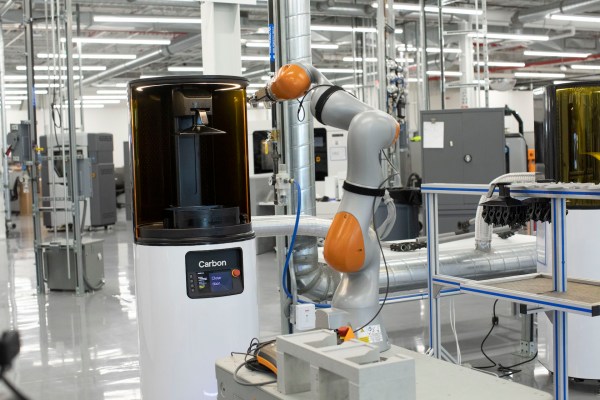Ford’s Advanced Manufacturing Center has developed an interface that allows machines from different suppliers to speak to each other in the same language and operate parts of the production line autonomously.
Automakers have been incorporating robotics into their manufacturing processes for decades to reduce costs and boost efficiency. But Ford’s patent-pending system solves a crucial bottleneck in the production line by using robots to operate the 3D printers through the night without human interaction.
The autonomous system marks the first time the Carbon 3D printers and the KUKA-built robots can talk to each other in the same language, opening limitless possibilities for other machines involved throughout the production process to collaborate.
So far, the venture has helped produce low-volume, custom car parts such as the brake line bracket for Mustang Shelby GT500 sports cars equipped with the Performance Package.
“This new process has the ability to change the way we use robotics in our manufacturing facilities,” Jason Ryska, director, global manufacturing technology development, said in a statement.
Javier, the name given to the wheeled robot from supplier KUKA, can run the 3D printer continuously without human interference, even once employees have gone home for the night. Ford says the robots are constantly learning from the printer data to help the automaker achieve more accuracy and reduce margins of error.
“At Ford’s Advanced Manufacturing Center, Javier is tasked with operating the 3D printers completely on his own,” Ford said in a statement. “He is always on time, very precise in his movements, and he works most of the day – taking only a short break to charge up.”
Usually, equipment from different suppliers are unable to interact because they use separate communication interfaces. Ford’s system allows equipment from different suppliers to talk to each other, sending commands and feedback in real time.
Once the Carbon 3D tells Javier that the printed car component is ready, Javier retrieves it and puts it aside for a human operator to collect later.
Ford has filed several patents for the technology underpinning its communication interfaces and the precise positioning of robots. Though the process is autonomous, human operators must upload the 3D designs to the printer and maintain the machinery.
